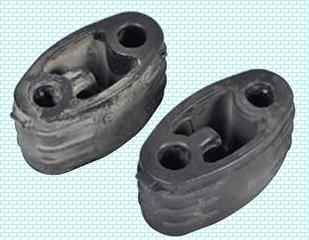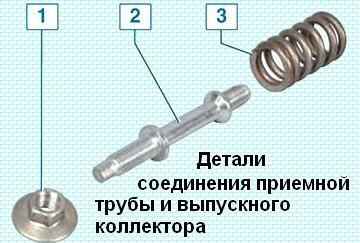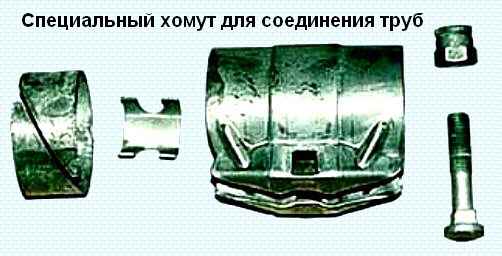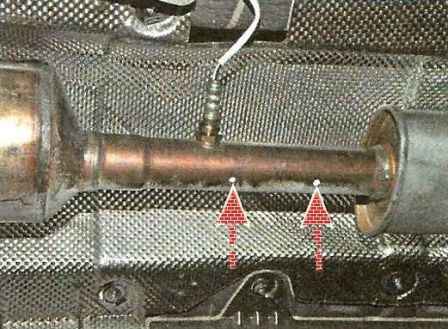A vehicle exhaust muffler system consists of a main muffler, an additional muffler, an exhaust gas catalytic converter, an exhaust manifold and connecting pipes

All parts of the system, except for the exhaust manifold, are welded together.

The exhaust system is attached to the body with rubber pads.

The exhaust manifold is secured with nuts to the cylinder head studs

A metal gasket is installed between the exhaust manifold and the cylinder head

The exhaust pipe is attached to the exhaust manifold flange with two studs and nuts

The flanges are tightened with two nuts and coil springs put on the exhaust manifold studs

An O-ring with a spherical surface is inserted between the flanges
A control sensor for the oxygen concentration in the exhaust gases (lambda probe) is installed at the bottom of the exhaust manifold.
The second oxygen concentration sensor (diagnostic) is installed in the pipe after the catalytic converter.
The three-way catalytic converter is designed to reduce emissions of carbon monoxide, nitrogen oxides and unburned hydrocarbons.
The catalytic converter is a ceramic block with many pores coated with afterburner catalysts: rhodium, palladium, platinum.
Passing through the pores, carbon monoxide is converted into carbon dioxide, unburned hydrocarbons into water vapor, and nitrogen oxides are reduced to harmless nitrogen.
The degree of gas purification in a serviceable converter reaches 98%.
For the normal operation of the converter, the composition of the exhaust gases (in particular, the oxygen content in them) must be within strictly specified limits.
If lead compounds are present in the exhaust gases, the catalytic converter and the oxygen concentration sensor will quickly fail.
Therefore, even short-term operation of a car on leaded gasoline is strictly prohibited.
Also, a faulty ignition system or power supply system can become the cause of the catalytic converter failure.
In the event of a misfire, unburned fuel, entering the converter, burns out and sinters the block with catalysts in it, which can lead to blockage of the exhaust system and stop (or severe loss of power) of the engine.
Mufflers and a catalytic converter connected by pipes are non-separable units; if they fail, they must be replaced with new ones.

Spare parts are supplied with a catalytic converter with a downpipe, additional and main mufflers with pipes of a certain length, as well as special pipe clamps.

To replace a separate element of the whole system, marks (punchings) are applied on its pipes in two places, along which pipes can be cut.

Maintenance of the exhaust system consists in its periodic inspection, checking for tightness of the connections and the presence of through corrosion, tightening loose connections and replacing the rubber suspension pads.





